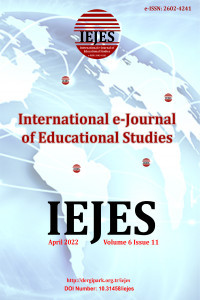Video-Based IBL and Conventional Approaches to Critical Thinking Skills in Terms of Gender
Critical thinking, inquiry based learning, conventional, gender
Video-Based IBL and Conventional Approaches to Critical Thinking Skills in Terms of Gender
Critical thinking, inquiry based learning, conventional, gender,
___
- Baker, M., Rudd, R., & Pomeroy, C. (2001). Relationships between critical and creative thinking. Journal of Southern Agricultural Education Research, 51(1), 173–188.
- Bustami, Y., Syafruddin, D., & Afriani, R. (2018). The implementation of contextual learning to enhance biology students’ critical thinking skills. Jurnal Pendidikan IPA Indonesia, 7(4), 451–457. https://doi.org/10.15294/jpii.v7i4.11721
- Duran, M., & Dökme, I. (2016). The effect of the inquiry-based learning approach on student’s critical-thinking skills. Eurasia Journal of Mathematics, Science and Technology Education, 12(12), 2887-2908. https://doi.org/10.12973/eurasia.2016.02311a
- Dwi Ferdiani, R., Yudiono, U., & Murniasih, T. R. (2019). Penggunaan mesin modifikasi jamu tradisional untuk meningkatkan hasil produksi. ABDI: Jurnal Pengabdian Dan Pemberdayaan Masyarakat, 1(2), 58-63. https://doi.org/10.24036/abdi.v1i2.13
- Etikan, I. (2016). Comparison of Convenience Sampling and Purposive Sampling. American Journal of Theoretical and Applied Statistics, 5(1), 1. https://doi.org/10.11648/j.ajtas.20160501.11
- Facione, P. A. (2011). Critical thinking : What it is and why it counts. In Insight assessment. Retrieved from https://www.insightassessment.com/CT-Resources/Teaching-For-and-About-Critical-Thinking/Critical-Thinking-What-It-Is-and-Why-It-Counts/Critical-Thinking-What-It-Is-and-Why-It-Counts-PDF
- Fisher, A. (2009). Berpikir kritis sebuah pengantar. Jakarta: Erlangga.
- Friedel, C., Irani, T., Rudd, R., Gallo, M., Eckhardt, E., & Ricketts, J. (2008). Overtly teaching critical thinking and inquiry-based learning: A comparison of two undergraduate biotechnology classes. Journal of Agricultural Education, 49(1), 72-84. https://doi.org/10.5032/jae.2008.01072
- Gowda, G. S., Komal, S., Sanjay, T. N., Mishra, S., Kumar, C. N., & Math, S. B. (2019). Sample size and its importance in research chittaranjan. Indian Journal of Psychological Medicine, 41(2), 138–143. https://doi.org/10.4103/IJPSYM.IJPSYM
- Halpern. (2013). Thought and knowledge an ıntroduction to critical thinking. In Thought and Knowledge. https://doi.org/10.7591/9781501738760
- Hasnunidah, N. (2017). Metodoologi penelitian pendidikan. In Academia.Edu.
- Heong, Y. M., Othman, W. B., Yunos, J. B. M., Kiong, T. T., Hassan, R. Bin, & Mohamad, M. M. B. (2011). The level of marzano higher order thinking skills among technical education students. International Journal of Social Science and Humanity, 1(2), 121–125.
- Huang, L., Doorman, M., & van Joolingen, W. (2021). Inquiry-based learning practices in lower-secondary mathematics education reported by students from China and the Netherlands. International Journal of Science and Mathematics Education, 19(7), 1505-1521.
- Indraswati, D., Marhayani, D. A., Sutisna, D., Widodo, A., & Maulyda, M. A. (2020). Critical thinking dan problem solving dalam pembelajaran ıps untuk menjawab tantangan abad 21. Sosial Horizon: Jurnal Pendidikan Sosial, 7(1), 12. https://doi.org/10.31571/sosial.v7i1.1540
- Khalaf, B. K., & Zin, Z. B. M. (2018). Traditional and inquiry-based learning pedagogy: A systematic critical review. International Journal of Instruction, 11(4), 545–564.
- Laursen, S. L., Hassi, M. L., Kogan, M., & Weston, T. J. (2014). Benefits for women and men of inquiry-based learning in college mathematics: A multi-institution study. Journal for Research in Mathematics Education, 45(4), 406–418. https://doi.org/10.5951/jresematheduc.45.4.0406
- Manahal, S. (2011). Pengaruh pembelajaran berbasis proyek pada matapelajaran biologi dan gender terhadap keterampilan metakognisi dan kemampuan berpikir kritis siswa sma di malang. Laporan Penelitian Malang: Lemlit UM.
- Myers, B., & Dyer, J. (2006). The ınfluence of student learning style on critical thinking skill. Journal of Agricultural Education, 47(1), 43-52. https://doi.org/10.5032/jae.2006.01043
- Nurrahmah, F. (2015). Profil proses berpikir kreatif siswa kelas X menurut Wallas dalam memecahkan masalah pada materi pokok gerak lurus ditinjau dari jenis kelamin dan prestasi belajar fisika. Universitas Islam Negeri Walisongo Semarang.
- OECD. (2018). What 15-year-old students in Indonesia know and can do. Programme for International Student Assessment (PISA) Result from PISA 2018, 1–10.
- Richardo, R. (2016). Program guru pembelajaran: Upaya peningkatan profesionalisme guru di abad 21. (November), 777–785.
- Sari, A. K., & Winda, T. (2019). Integrasi keterampilan abad 21 dalam modul sociolinguistics: Keterampilan 4C (Collaboration, communication, critical thinking, dan creativity). Jurnal Muara Pendidikan, 4(2), 455–466.
- Siregar, R. N., Mujib, A., Hasratuddin, & Karnasih, I. (2020). Peningkatan kemampuan berpikir kreatif siswa melalui pendekatan matematika realistik. Edumaspul Jurnal Pendidikan, 4(1), 56–62.
- Stockdale, R. L. W. and S. L. (2003). High-performing students with low critical thinking skills Journal of General Education This, 52(3), 200-226.
- Susilowati, R., Relmasira, S. C., & Hardini, A. T. A. (2018). Penerapan model problem based learning berbantu media audio visual untuk meningkatkan berpikir kritis kelas 4 SD. Jurnal Imiah Pendidikan Dan Pembelajaran, 2(1), 57–69. https://doi.org/10.23887/jipp.v2i1.13870
- Utami, M. T., Koeswati, H. D., & Giarti, S. (2019). Model problem based learning (PBL) berbantuan media audio visual untuk meningkatkan keteramoilan berpikir kritis pada siswa kelas 5 Sekolah Dasar. Maju, 6(1), 80–91.
- Wiyoko, T. (2019). Analisis profil kemampuan berpikir kritis mahasiswa pgsd dengan graded response models pada pembelajaran ıpa analysis of capability profile of critical thinking of pgsd students with graded response on science learning. Ijis Edu, 1(1), 25–32.
- Başlangıç: 2017
- Yayıncı: Tamer KUTLUCA
Oğuzhan ALTUNGÜL, Didem YAVUZ SÖYLER, Mesut BULUT
Nimet BARÇIN, Arzu AYDOĞAN YENMEZ
Ensar YILDIZ, Ayşegül ÖĞÜTCEN, Berrin AKMAN
Distance Education Competencies of Physical Education Teachers: Elazığ Province
Oğuzhan ALTUNGÜL, Didem YAVUZ SÖYLER
Tuba YENİL, Burçin GÖKKURT ÖZDEMİR
Assessment of Mobile Phone Usage and Loneliness Levels of Faculty of Sports Sciences Students
Süreyya Yonca SEZER, Kubilay ŞENBAKAR
Cognitive and Metacognitive Strategies in Problem-Posing Tasks in the Context of Science
